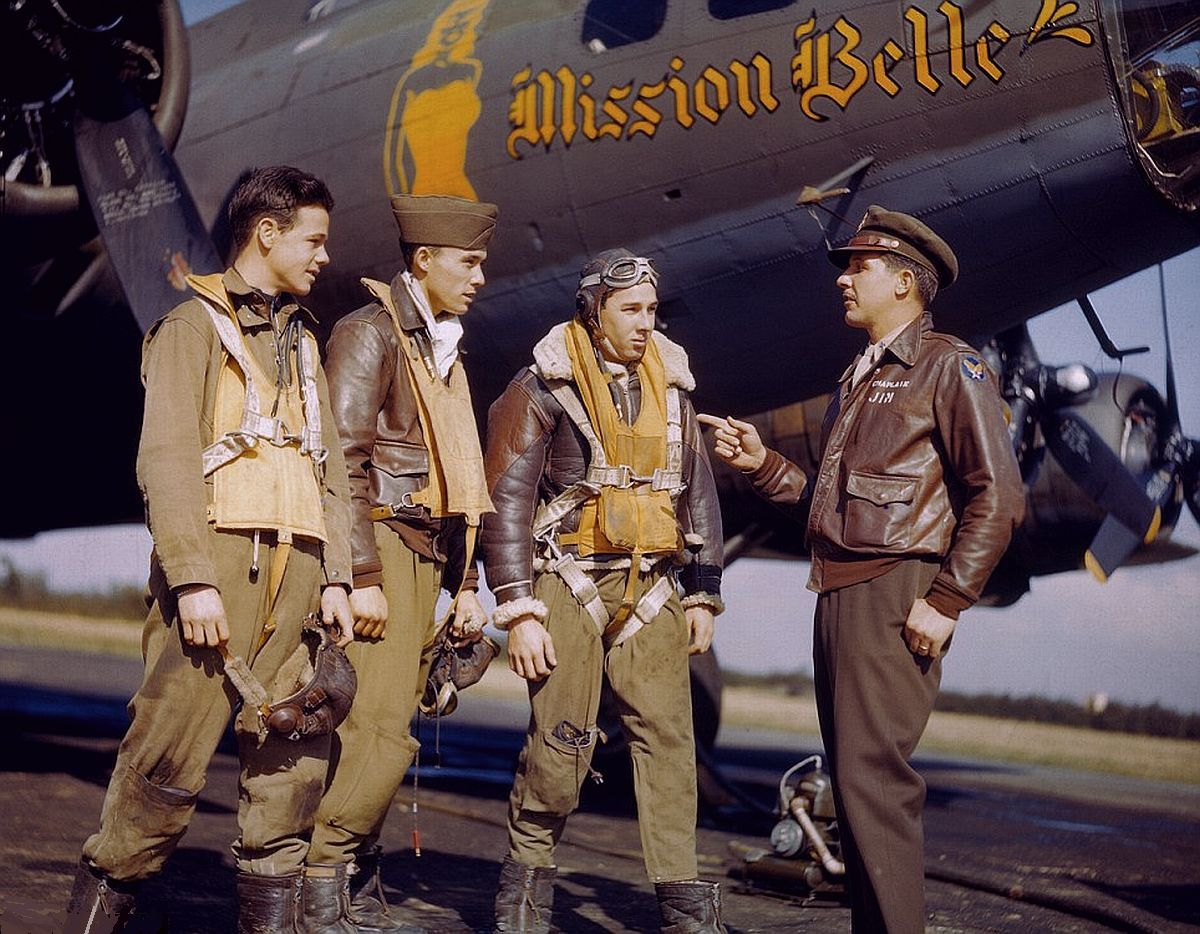
| Caption | Gunners of the 385th Bomb Group pose in front of B-17F Fortress "Mission Belle" and listen to a word from the Chaplain, James O. Kincannon (“Chaplain Jim”), at Great Ashfield Air Field, England, UK, late 1944. ww2dbase | |||||
| Photographer | Samuel Goldstein | |||||
| Source | ww2dbaseUnited States Army Air Force | |||||
| More on... |
| |||||
| Photo Size | 1,200 x 934 pixels | |||||
| Photos at Same Place | Suffolk, England, United Kingdom | |||||
| Added By | David Stubblebine | |||||
| Licensing | Public Domain. According to the United States copyright law (United States Code, Title 17, Chapter 1, Section 105), in part, "[c]opyright protection under this title is not available for any work of the United States Government". Please contact us regarding any inaccuracies with the above information. Thank you. |
Please consider supporting us on Patreon. Even $1 per month will go a long way! Thank you. Please help us spread the word: Stay updated with WW2DB: |
Visitor Submitted Comments
2.  David Stubblebine says:
David Stubblebine says:
9 Jun 2018 12:22:04 PM
Anonymous (above):
Thank you very much for leaving your comment. It prompted me to do a lot more looking into this photo and this aircraft. Firstly, I concur with everything you said, adding that this aircraft was not only with the 385th Bomb Group but flew with the 551st Bomb Squadron. The caption and location information has been updated. Thank you again.
This particular photograph was a staged photo for the benefit of the press. None of these men were assigned to this aircraft. The American Air Museum in Britain has an extensive caption they say is from the back of this photo. That identifies the gunners a (L to R): TSgt Howard G Butler of Dallas, Tex; SSgt Walter F Stephens of Los Angeles, Calif, and SSgt Roger D Palmer of Grand Island, Neb.
This aircraft (B-17F #42-30197) was damaged by flak 11 Apr 1944 during their bomb run over the synthetic fuel factories in Pölitz, Germany (now Poland) and later crash landed in Kristianopel, Sweden where all ten crewmen survived and were interred.
9 Jun 2018 12:22:04 PM
Anonymous (above):
Thank you very much for leaving your comment. It prompted me to do a lot more looking into this photo and this aircraft. Firstly, I concur with everything you said, adding that this aircraft was not only with the 385th Bomb Group but flew with the 551st Bomb Squadron. The caption and location information has been updated. Thank you again.
This particular photograph was a staged photo for the benefit of the press. None of these men were assigned to this aircraft. The American Air Museum in Britain has an extensive caption they say is from the back of this photo. That identifies the gunners a (L to R): TSgt Howard G Butler of Dallas, Tex; SSgt Walter F Stephens of Los Angeles, Calif, and SSgt Roger D Palmer of Grand Island, Neb.
This aircraft (B-17F #42-30197) was damaged by flak 11 Apr 1944 during their bomb run over the synthetic fuel factories in Pölitz, Germany (now Poland) and later crash landed in Kristianopel, Sweden where all ten crewmen survived and were interred.
All visitor submitted comments are opinions of those making the submissions and do not reflect views of WW2DB.
Change View
Desktop ViewSearch WW2DB
Modern Day Location
| WW2-Era Place Name | Suffolk, England, United Kingdom |
| Lat/Long | 52.2572, 0.9356 |
Random Photograph
Three US Navy PBY-5A Catalina aircraft of VP-52 in flight in the southwest Pacific area, Dec 1943Current Site Statistics
- » 1,167 biographies
- » 337 events
- » 44,601 timeline entries
- » 1,243 ships
- » 350 aircraft models
- » 207 vehicle models
- » 376 weapon models
- » 123 historical documents
- » 261 facilities
- » 470 book reviews
- » 28,504 photos
- » 366 maps
Famous WW2 Quote
"With Germany arming at breakneck speed, England lost in a pacifist dream, France corrupt and torn by dissension, America remote and indifferent... do you not tremble for your children?"Winston Churchill, 1935
8 Jun 2018 09:22:05 AM
This B-17 was actually with the 385th Bomb Group which consisted of the 548th, 549th, 550th and 551st bomb squadrons. This would have been at Great Ashfield, England.